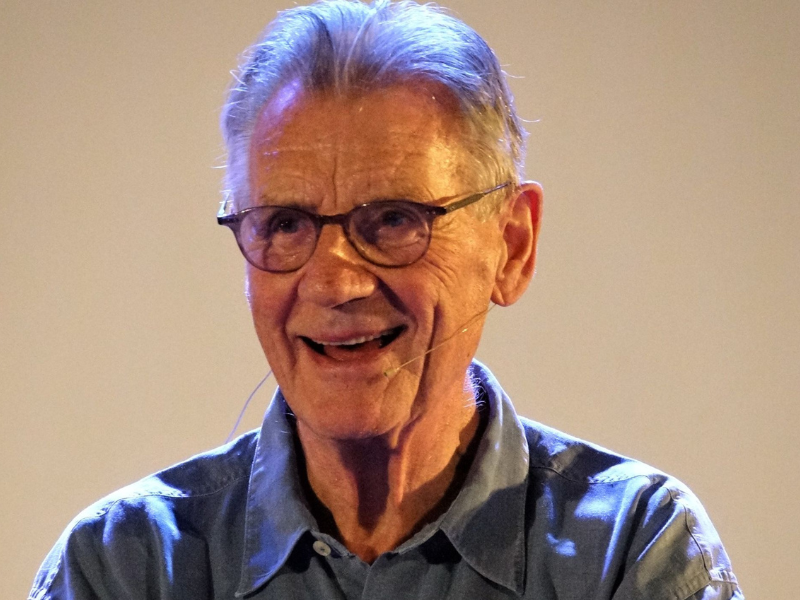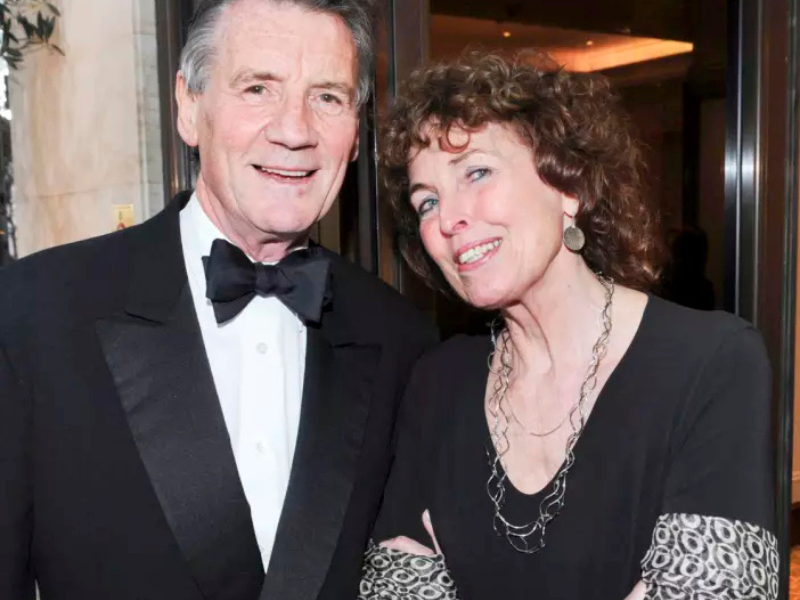Introduction: A Gentleman of Comedy
When talking about the greatest names in British comedy, Michael Palin stands as a towering figure. Beloved for his warm presence, sharp wit, and versatile acting, Palin is much more than just a comedian. He is a writer, actor, traveler, documentarian, and one of the most admired public figures in Britain. Best known as a member of the iconic Monty Python troupe, Palin’s work shaped the face of modern comedy and continues to inspire performers worldwide. His career spans decades, and his influence stretches across theatre, television, cinema, and literature.
This blog explores Michael Palin’s incredible journey — from his early life and career beginnings, to his role in Monty Python, and finally his legacy as one of comedy’s true greats.
Early Life: The Making of a Storyteller
Michael Edward Palin was born on May 5, 1943, in Sheffield, England. His childhood provided the seeds of his creative spirit. From an early age, Palin was fascinated by storytelling, often inventing characters and short plays for fun.
- Education: He studied at Oxford University, where he read Modern History. Oxford would play a crucial role in shaping his career, introducing him to other budding performers and writers who were exploring satire and humor in their own ways.
- Love for Writing: Palin’s strength in writing was evident even in his youth. His ability to blend humor with intellectual depth would later define much of his work.
These formative years were not just about education but about building the creative instincts that would later shine in Monty Python.
The Pre-Python Years: Television and Comedy Beginnings
Before Monty Python became a cultural phenomenon, Michael Palin was already active in British comedy. His early work included:
- Writing for The Frost Report (1966): This television show introduced him to future collaborators.
- Do Not Adjust Your Set (1967–1969): Palin, along with Terry Jones, Eric Idle, and others, created sketches that hinted at the absurdist humor Monty Python would later perfect.
- Theatre and Variety Work: Palin also wrote and performed for stage and television variety shows, honing his craft.
By the late 1960s, Palin was already recognized as a promising comedic voice.

The Birth of Monty Python
In 1969, Michael Palin became one of six founding members of Monty Python’s Flying Circus, alongside John Cleese, Graham Chapman, Terry Gilliam, Eric Idle, and Terry Jones. Together, they revolutionized comedy.
Breaking the Rules of Comedy
Monty Python defied traditional sketch formats. Instead of building toward a single punchline, their sketches often ended abruptly, bled into each other, or dissolved into animated sequences. This surreal, anarchic style became their signature.
Palin’s Role in the Group
Michael Palin quickly became the troupe’s “everyman” — charming, relatable, and versatile. His natural warmth balanced the more abrasive humor of Cleese or Chapman.
Some of his most beloved contributions include:
- The Cheese Shop Sketch (with Cleese).
- The Dead Parrot Sketch (as the exasperated shopkeeper opposite Cleese).
- The Lumberjack Song, a satirical take on gender and masculinity.
Palin’s ability to play ordinary men caught in absurd situations became a hallmark of his comedic style.
Signature Characters and Sketches
Michael Palin’s strength lay in his versatility. He could play:
- Authority Figures: Judges, policemen, or government officials — always delivered with a humorous twist.
- The Bumbling Everyman: Ordinary people swept into bizarre scenarios.
- Outrageous Personalities: Such as the flamboyant lumberjack or peculiar shopkeepers.
Some of Palin’s unforgettable performances include:
- The Argument Clinic sketch, where he calmly debates whether his customer has truly had an argument.
- The Spanish Inquisition, where his timing as one of the bumbling inquisitors made the sketch legendary.
- His role as Pontius Pilate in Life of Brian, complete with his comical speech impediment.
Palin’s blend of charm and comic timing made him one of Monty Python’s most universally adored members.
Monty Python on the Big Screen
Palin’s contributions extended far beyond television. He played central roles in Python’s films:
- Monty Python and the Holy Grail (1975): Palin shone in multiple roles, including Sir Galahad the Pure and the pesky guards at the castle.
- Monty Python’s Life of Brian (1979): Palin’s versatility stood out in his portrayal of Pontius Pilate, a character still quoted decades later.
- Monty Python’s The Meaning of Life (1983): Once again, Palin’s comic range was on full display in a variety of roles.
These films cemented Monty Python’s reputation as pioneers of comedy cinema.
Partnership with Terry Jones
Michael Palin shared a special creative bond with fellow Python member Terry Jones. The two co-wrote many sketches and often worked together outside of Monty Python.
- They collaborated on Ripping Yarns (1976–1979), a television series parodying adventure stories. Palin’s characters in Ripping Yarns highlighted his gift for blending satire with storytelling.
- Their long-term partnership was built on shared humor, imagination, and mutual respect.
Jones and Palin’s collaboration enriched both of their careers, proving that their creative magic extended well beyond Monty Python.
The Gentle Face of Monty Python
While Monty Python thrived on chaos, satire, and often shocking humor, Michael Palin emerged as the troupe’s “gentleman.” Known for his kindness and humility, he balanced the more extreme personalities in the group.
His warmth made audiences connect with him, whether he was playing a silly character or narrating a surreal sketch. This quality not only made him beloved within Monty Python but also laid the groundwork for his future career as a presenter and documentarian.
Transition Beyond Python
By the mid-1980s, Monty Python had largely concluded their group projects. For Michael Palin, this was not an end but the beginning of a new chapter.
He continued to act, write, and perform, but soon he would reinvent himself in ways that surprised both fans and critics.
Transitioning Beyond Monty Python
After Monty Python’s major projects concluded, Michael Palin faced a crossroads. Many members went on to solo comedy projects, while some focused on writing or directing. Palin, however, chose a unique path: combining his love for storytelling with travel, history, and documentary filmmaking.
He demonstrated that a comedian’s wit could blend seamlessly with intellect and curiosity. His career post-Python proved that humor could serve as a bridge to explore culture, geography, and human stories.

Travel Documentaries: A New Chapter
One of the most defining aspects of Palin’s post-Python career is his work as a travel documentarian. He has traveled extensively, bringing viewers along for the ride in a way few entertainers have ever done.
- Around the World in 80 Days (1989):
Palin retraced Phileas Fogg’s journey, traveling by public transport and documenting his experiences. His humor, charm, and curiosity made the series both educational and entertaining. - Pole to Pole (1992):
Palin traveled from the North Pole to the South Pole, encountering extreme environments and cultures. His lighthearted approach allowed audiences to appreciate the human stories behind harsh landscapes. - Full Circle: Alaska to Patagonia (1997):
This documentary showcased his ability to find humor and warmth even in long, challenging journeys. Palin’s interactions with local people brought both laughter and insight. - Hemingway Adventure (1999) and New Europe (2007):
These documentaries demonstrated his versatility, focusing not only on geography but also on literary and cultural themes.
Through these projects, Palin became known as the “gentleman traveler” — intelligent, witty, and relatable. His humor never overshadowed the stories he told; instead, it enriched them.
Acting and Voice Work Beyond Monty Python
While travel documentaries became a major part of his career, Palin never abandoned acting. He appeared in films, television dramas, and voice acting projects:
- A Fish Called Wanda (1988): As Ken Pile, he showcased his comedic talent in a star-studded ensemble.
- Brazil (1985, Terry Gilliam): His subtle humor enhanced this dystopian satire.
- Voice Work: Films like The Adventures of Pinocchio and various animated projects benefited from his distinctive and expressive voice.
Palin’s acting post-Python demonstrated his ability to adapt to different genres — comedy, drama, and family entertainment — while maintaining his unique charm.
Writing: Beyond the Screen
Palin’s literary contributions are another facet of his diverse career. He has authored travel books, diaries, and humorous essays that reflect his wit and keen observations:
- Full Circle (1997) – A companion to the Pole to Pole documentary, blending travel narrative with light-hearted commentary.
- Hemingway Adventure (1999) – A combination of biography, travelogue, and humor.
- Diaries and Memoirs – Including his reflections on Monty Python, travel, and life in show business.
His writing style mirrors his on-screen persona: insightful, witty, and accessible. It allows fans to enjoy his humor in a reflective, literary format.
Awards and Recognition
Michael Palin’s career has been marked by numerous honors:
- BAFTA Awards: Recognized for his acting, writing, and contributions to television.
- Order of the British Empire (CBE, 2000): For services to drama and charity.
- Royal Geographical Society: Awarded for his contributions to exploration and travel literature.
- International Recognition: His documentaries have been celebrated globally for combining education and entertainment.
These accolades reflect not only his comedic talent but also his versatility and humanity.
Collaborations and Partnerships
Palin’s career, both in and out of Monty Python, is marked by collaborations:
- Monty Python Members: Long-term friendships and creative synergy with John Cleese, Eric Idle, Terry Jones, Graham Chapman, and Terry Gilliam.
- Directors and Writers: Collaborated with Terry Gilliam on surreal films, and with writers in travel documentaries to craft compelling narratives.
- Human Connections: Palin’s respectful and curious interactions with locals during his travels often became central to the humor and humanity in his documentaries.
Legacy in Comedy and Culture
Michael Palin’s influence stretches far beyond the comedy troupe he helped create. His legacy includes:
- Expanding British Comedy: He helped redefine sketch and absurdist comedy, influencing generations of comedians.
- Pioneering the Comedian-Traveler Genre: Palin showed that a comedian could also be an explorer and storyteller.
- Humanizing Humor: His warm, gentle approach allowed audiences to laugh while also learning about cultures, human behavior, and history.
Impact on Modern Entertainment
Comedians and entertainers today cite Palin as an inspiration:
- His ability to mix intelligence, humor, and humanity has become a template for modern comedy documentaries.
- Writers and performers continue to emulate his timing, versatility, and ability to make absurdity relatable.
- Shows like Michael Palin’s Travels have influenced popular formats in travel television worldwide.
Michael Palin’s Philosophy of Comedy
Michael Palin approaches comedy with a unique blend of intelligence, humility, and warmth. Unlike many comedians who rely solely on shock or provocation, Palin’s humor is rooted in observation, empathy, and timing.
Key elements of his comedic philosophy include:
- Relatability: Even in absurd scenarios, Palin’s characters remain grounded. Audiences see themselves in the ordinary everyman he often portrays.
- Curiosity: His travel documentaries reflect a genuine interest in people and cultures, translating to comedy that feels natural rather than forced.
- Teamwork: Comedy is collaborative, and Palin’s career demonstrates how ensemble work — whether in Monty Python or Ripping Yarns — produces richer humor.
- Subtlety and Nuance: While he can deliver broad physical comedy, much of Palin’s humor lies in nuance — timing, facial expressions, and understated delivery.
This philosophy has allowed him to maintain relevance over decades and appeal to multiple generations.
Behind-the-Scenes of Monty Python
Michael Palin’s behind-the-scenes role in Monty Python is as important as his on-screen presence.
- Creative Writing: Alongside John Cleese, Terry Jones, and Graham Chapman, Palin contributed sketches, dialogues, and storyboards.
- Problem-Solving: Known for his calm demeanor, Palin often mediated creative conflicts, helping maintain group cohesion.
- Experimentation: He encouraged fellow Pythons to push boundaries in sketch comedy, including surreal transitions, animated sequences, and breaking the fourth wall.
Anecdotes from the Monty Python era highlight his generosity and professionalism. For instance, he often rehearsed extensively to support cast members struggling with tricky lines, showing his commitment to ensemble comedy.
Signature Acting Techniques
Palin’s style is marked by versatility and subtle physicality. His acting techniques include:
- Facial Expressiveness: His face conveys incredulity, confusion, or delight without exaggerated gestures.
- Vocal Modulation: Palin varies pitch, tone, and cadence to suit each character, from high-energy sketches to understated travel narration.
- Character Immersion: Whether playing Pontius Pilate or a lumberjack, Palin fully inhabits the character while maintaining comedic timing.
- Adaptability: He easily shifts between absurdist comedy, satire, drama, and documentary narration.
These techniques allow him to engage audiences across diverse formats.
Memorable Collaborations Beyond Python
Palin continued collaborating with notable figures in comedy, travel, and film:
- Terry Jones: Beyond Python, they co-created Ripping Yarns, blending historical parody with absurd humor.
- Eric Idle and John Cleese: Occasional reunions in sketches, films, and charity performances kept the spirit of Monty Python alive.
- Documentary Teams: His travel documentaries showcase collaboration with producers, camera crews, and locals worldwide, turning real-life encounters into engaging storytelling.
Legacy and Influence on Comedy
Michael Palin’s impact on British and global comedy is enormous:
- Monty Python Influence: He helped redefine sketch and surrealist comedy, inspiring comedians like Eddie Izzard, Rowan Atkinson, and contemporary ensemble troupes.
- Gentleman Humor: Palin’s style combines warmth with wit, proving humor need not be abrasive to be effective.
- Blending Genres: He showed that comedy could mix with travel, history, and education, creating entertaining yet informative content.
His legacy lies not only in laughter but in elevating the art of comedy to include intelligence, humanity, and universal appeal.

Personal Life and Public Persona
Michael Palin has remained a private, grounded figure despite global fame. He is admired for:
- Humility: Despite accolades and international recognition, he often downplays his own achievements.
- Philanthropy: Supports various charitable causes quietly and consistently.
- Authenticity: Palin’s humor reflects a genuine personality — witty, curious, empathetic, and consistently kind.
Fans appreciate his relatability, making him both a comedy icon and a beloved public figure.
Continuing Relevance
Even today, Palin’s work resonates:
- His Monty Python sketches are studied in comedy schools and referenced across media.
- Travel documentaries inspire new formats and presenters.
- Interviews and memoirs reveal timeless insights into creativity, collaboration, and humor.
The combination of laughter, humanity, and intelligence ensures that Michael Palin’s work will remain relevant for generations to come.
Cultural Impact
Michael Palin helped shape the perception of British comedy abroad. His travel documentaries, films, and sketches introduced international audiences to:
- British wit and dry humor
- The absurdist, intellectual style of Monty Python
- Warmth, curiosity, and charm as central elements in performance
He elevated comedy beyond entertainment, turning it into an art form that educates, inspires, and delights.
Conclusion: Celebrating a Comedy Legend
Michael Palin’s career spans comedy, acting, writing, and travel — a rare combination of talents unified by intelligence, warmth, and curiosity. From the chaotic absurdity of Monty Python sketches to his insightful travel documentaries, Palin has left an indelible mark on both comedy and culture.
His ability to craft unforgettable characters, combine wit with humanity, and continually reinvent himself serves as a blueprint for aspiring comedians and entertainers. Through decades of performance, writing, and exploration, Michael Palin embodies the spirit of Monty Python: clever, surreal, and endlessly entertaining.
In celebrating Michael Palin, we celebrate the power of comedy — not just to amuse, but to illuminate, connect, and inspire. His work reminds us that laughter, when combined with intellect and empathy, transcends time and borders.


